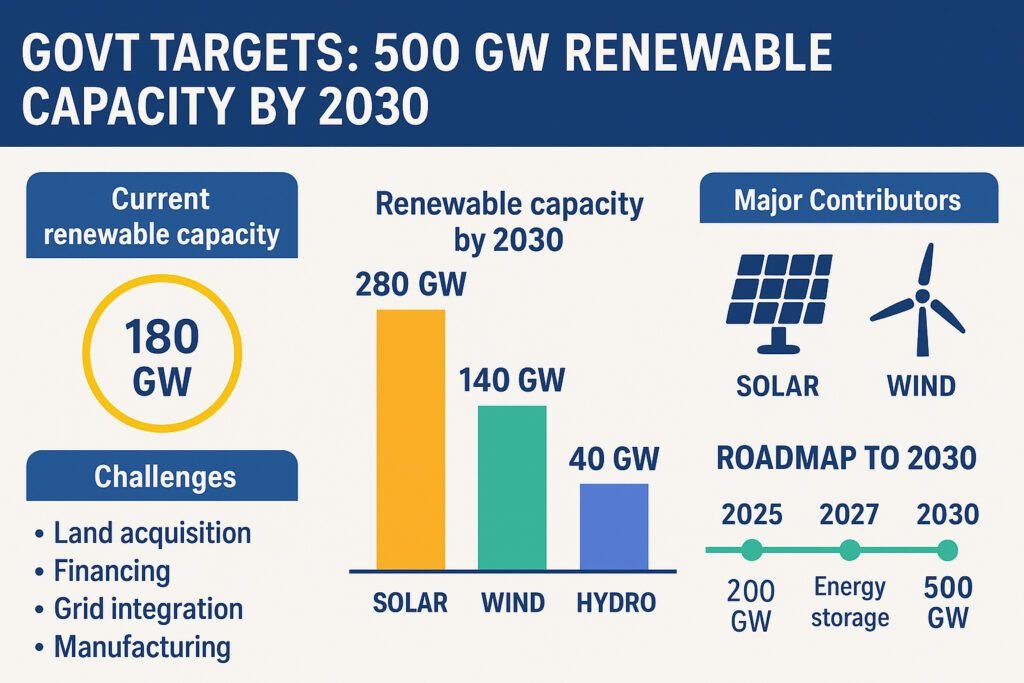India is standing at the cusp of a clean energy revolution. With rising concerns over climate change, fossil fuel dependency, and the need for sustainable development, the Government of India has set an ambitious yet transformative goal: achieving 500 gigawatts (GW) of renewable energy capacity by 2030. This target is not just a number—it is a commitment towards a greener, resilient, and energy-secure future.
The Context: Why 500 GW by 2030?
India is the third-largest energy consumer in the world, and its demand is projected to grow significantly over the next decade due to population growth, urbanization, and industrialization. At present, a large share of electricity comes from coal, contributing to carbon emissions and air pollution.
By committing to 500 GW of renewable capacity, India aligns itself with the Paris Agreement and its net-zero emissions target by 2070. This capacity will come primarily from solar, wind, hydro, and bio-energy, positioning India as a global leader in the renewable energy sector.
Current Status of India’s Renewable Energy
As of 2025, India’s installed renewable energy capacity stands at over 180 GW, accounting for more than 40% of the total installed power capacity. The breakdown is as follows:
-
Solar Power: ~85 GW
-
Wind Power: ~46 GW
-
Hydropower (small & large): ~51 GW
-
Bio-energy: ~12 GW
This progress showcases India’s steady shift away from fossil fuels and highlights the potential to accelerate further growth in the next five years.
Solar Energy: The Driving Force
Solar energy will play the biggest role in achieving the 500 GW milestone. India has abundant sunshine, with over 300 sunny days annually.
Key solar initiatives include:
-
National Solar Mission (NSM): Aimed at developing 100 GW of solar power.
-
Rooftop Solar Program: Encouraging adoption by households, commercial, and industrial sectors.
-
Ultra Mega Solar Parks: Large-scale solar parks across states like Rajasthan, Gujarat, and Madhya Pradesh.
By 2030, the government expects solar alone to contribute around 280 GW, making it the backbone of India’s renewable roadmap.
Wind Power: Harnessing India’s Coastlines
Wind energy is the second largest contributor to renewable capacity. States such as Tamil Nadu, Gujarat, Karnataka, and Maharashtra have strong wind corridors.
Future plans include:
-
Expanding onshore wind projects in southern and western states.
-
Developing offshore wind projects in Gujarat and Tamil Nadu, where initial pilot projects are already underway.
The target is to achieve nearly 140 GW of wind energy by 2030.
Hydropower and Bio-energy
While solar and wind will dominate, hydropower and bio-energy will provide stability and diversification.
-
Hydropower: India aims to expand both large and small hydro projects in the Himalayan region. Pumped storage projects are also being promoted to complement intermittent renewables.
-
Bio-energy: From biomass, bagasse, and waste-to-energy projects, bio-energy is expected to contribute 15–20 GW.
Why This Target Matters
1. Climate Change Mitigation
India is one of the countries most vulnerable to climate impacts. Transitioning to renewables reduces dependence on coal, cutting down emissions and air pollution.
2. Energy Security
By reducing reliance on imported coal and oil, India strengthens its energy independence.
3. Economic Growth & Jobs
The renewable sector is labor-intensive. According to estimates, achieving 500 GW could generate millions of jobs in manufacturing, installation, maintenance, and innovation.
4. Technological Leadership
India can become a global hub for renewable technologies such as solar panels, green hydrogen, and battery storage, boosting exports.
Policy and Government Support
To realize this ambitious target, the government has rolled out a series of policies and incentives:
-
Production-Linked Incentive (PLI) Schemes: Encouraging domestic manufacturing of solar modules and batteries.
-
Renewable Purchase Obligations (RPOs): Mandating state utilities to purchase a fixed share of renewables.
-
Green Energy Corridors: Building transmission lines to connect renewable-rich states to demand centers.
-
Solar Parks and Ultra-Mega Projects: Large-scale investments to harness economies of scale.
-
International Solar Alliance (ISA): India-led initiative promoting solar deployment globally.
Challenges Ahead
Despite the promise, several hurdles remain:
-
Land Acquisition: Large-scale solar and wind projects require vast tracts of land, often facing resistance from communities.
-
Financing: Achieving 500 GW will need investments of over $500 billion, requiring public-private partnerships and foreign investments.
-
Grid Integration: Renewable power is intermittent; without sufficient storage and smart grids, stability could be a challenge.
-
Domestic Manufacturing: Currently, India imports a significant portion of solar equipment from China. Scaling domestic production is critical.
-
Policy Uncertainty: State-level regulatory hurdles and tariff disputes can slow progress.
The Role of Energy Storage & Green Hydrogen
To balance renewable integration, energy storage technologies (like lithium-ion batteries and pumped hydro) will be essential.
Additionally, green hydrogen—produced using renewable power—can decarbonize industries like steel, cement, and fertilizers. The government has already launched the National Hydrogen Mission, aiming to position India as a global hub for hydrogen production.
International Impact
If India meets its 500 GW target, it will:
-
Rank among the top three renewable energy producers globally.
-
Reduce carbon emissions by nearly 1 billion tons annually.
-
Strengthen India’s voice in global climate negotiations, inspiring other developing countries to follow suit.
Roadmap to 2030
-
2025 Milestone: Achieve ~250 GW of renewables.
-
2027 Milestone: Integration of large-scale energy storage solutions.
-
2028–2030: Expansion of green hydrogen and offshore wind projects.
-
2030 Goal: 500 GW renewable capacity, with majority share from solar and wind.

